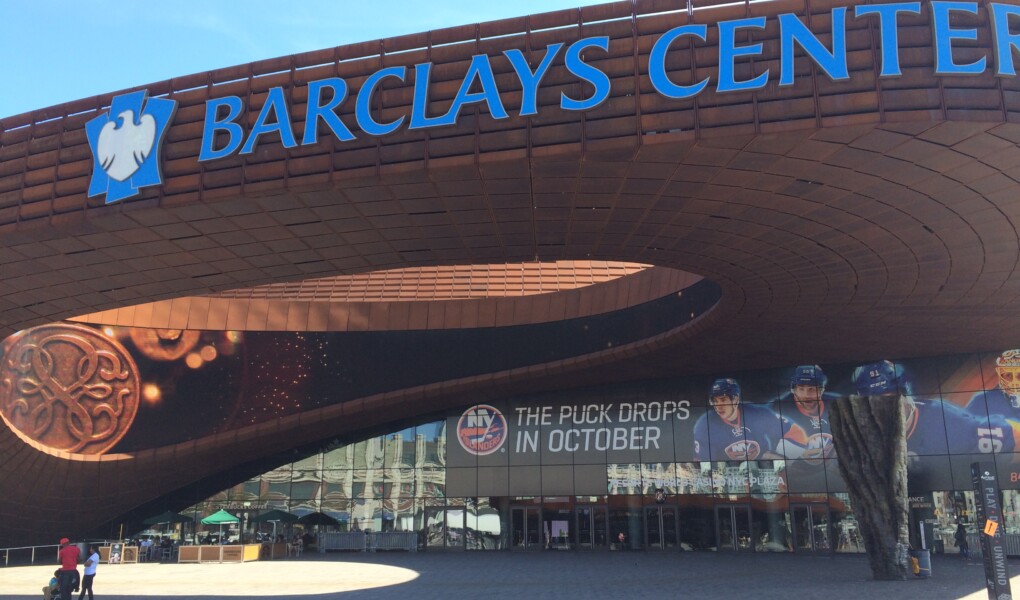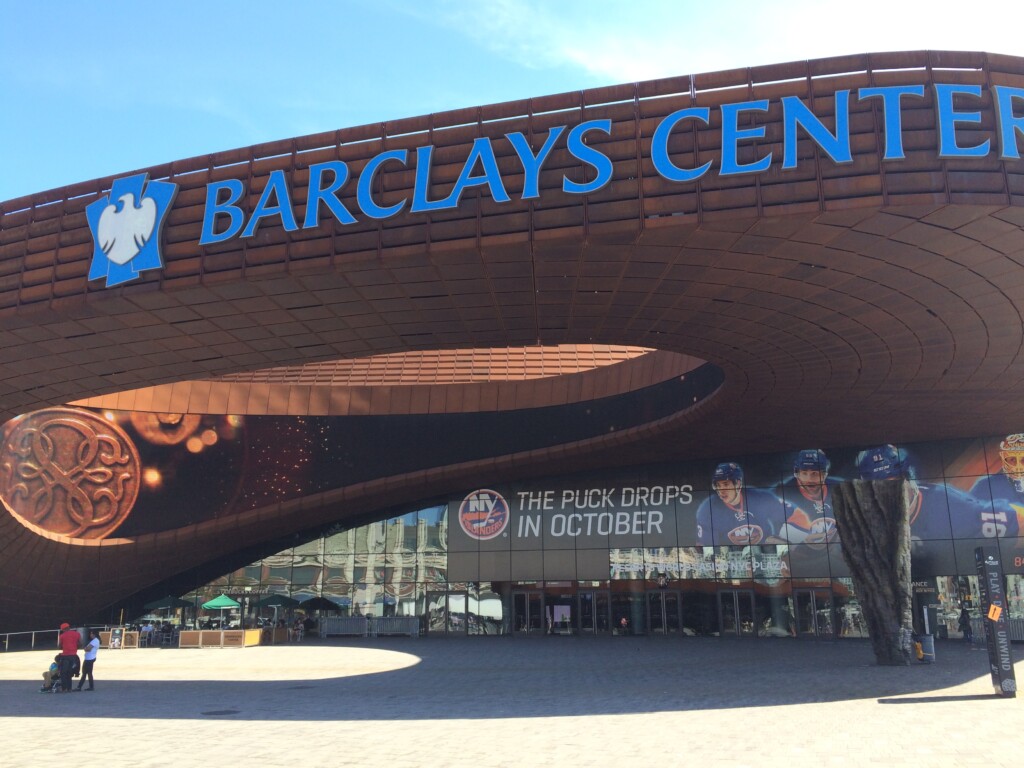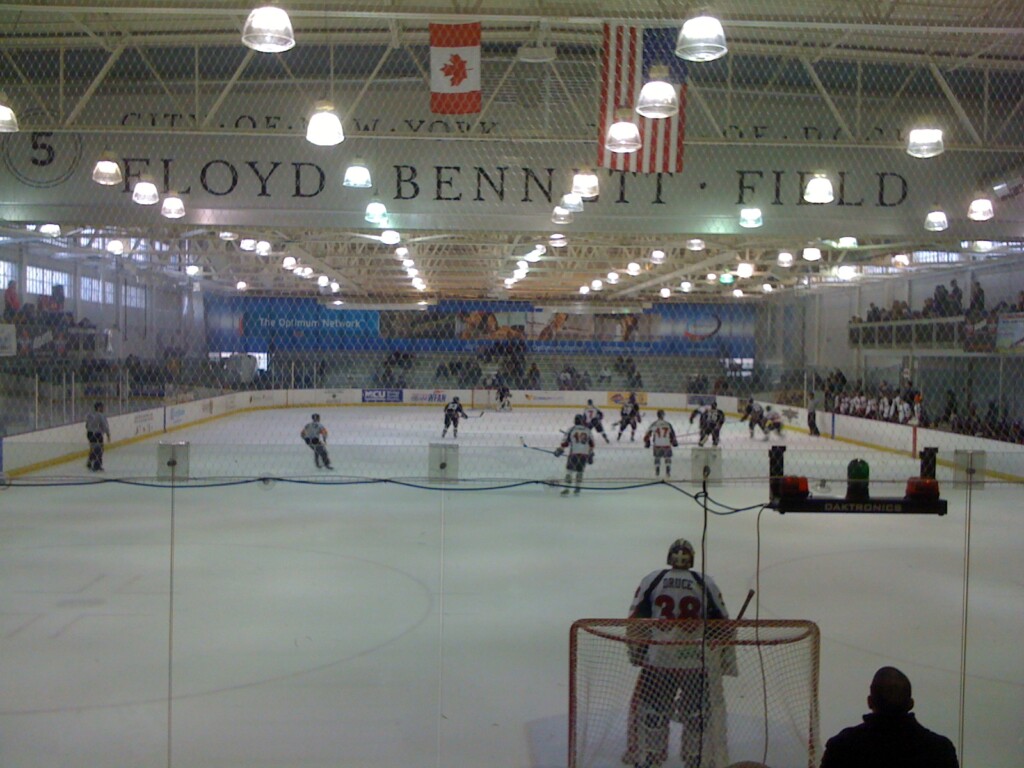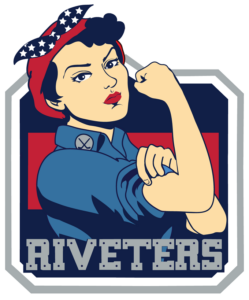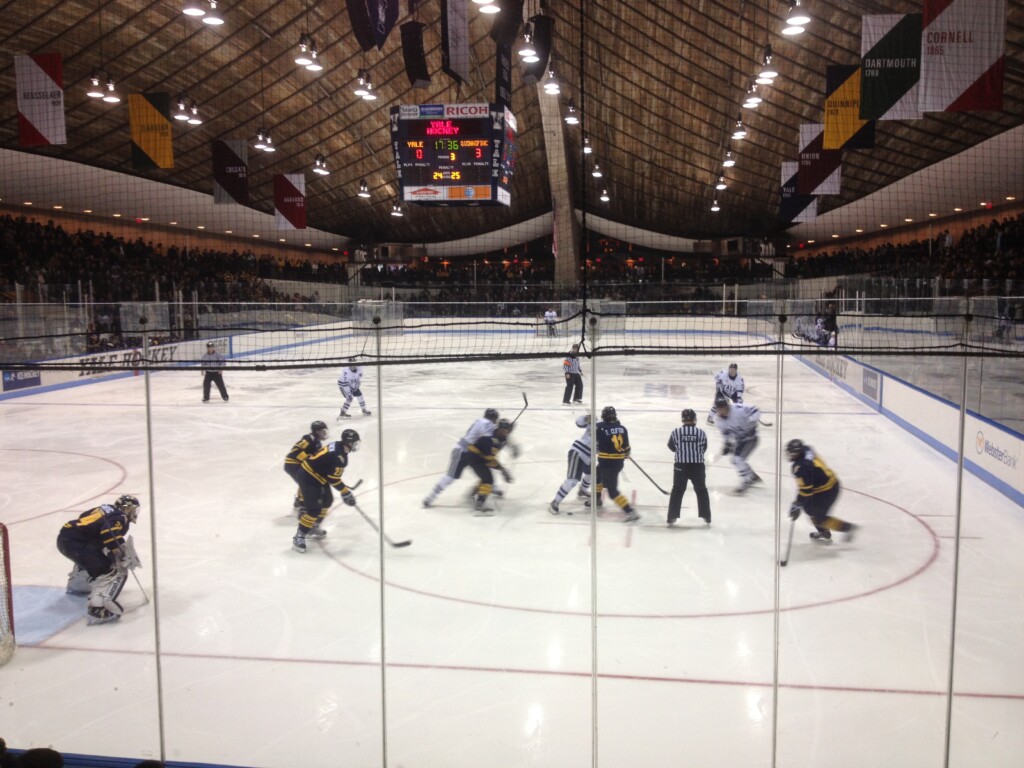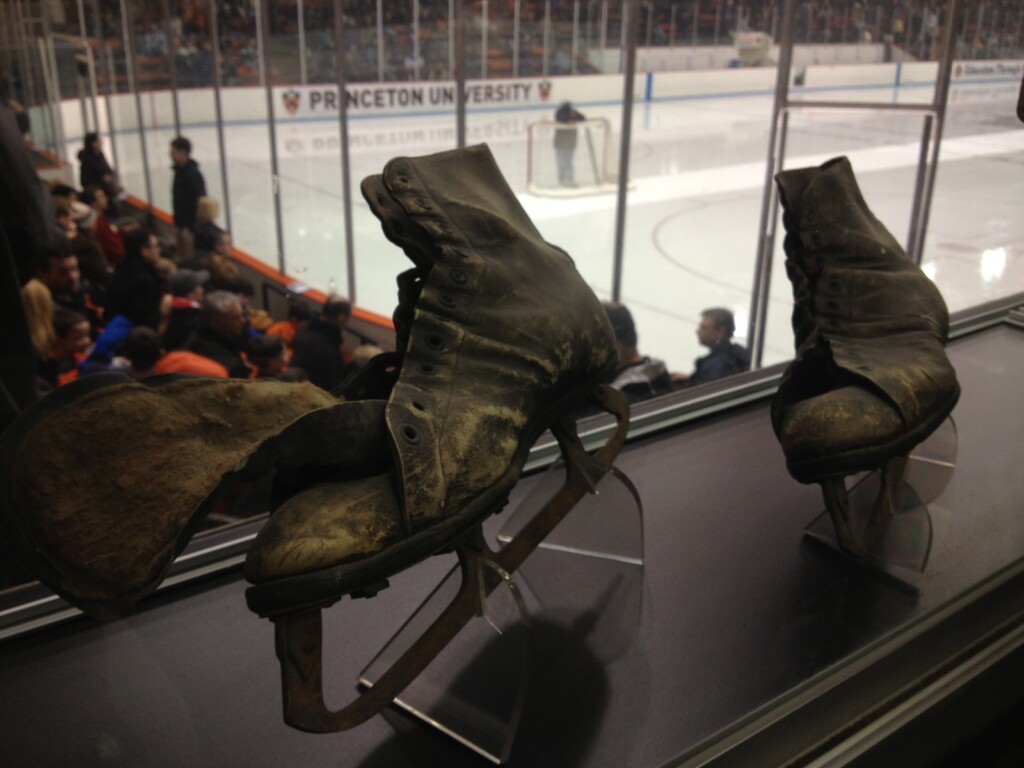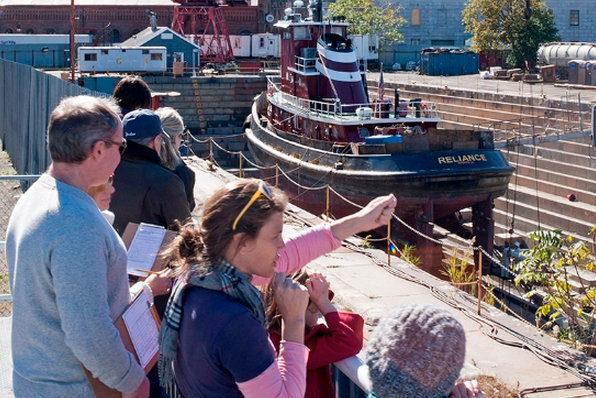Yesterday marked the beginning of the new NHL season, so we have put together a season preview that not only gives you a short run-down on the local top-tier teams (Rangers, Islanders, Devils), but also the many opportunities to watch minor league and college hockey within a short distance of the city, tips on how to get there and have a great time, and a bit of background information on the different teams and leagues.
So the next time Canadian major junior hockey eligibility rules come up at a cocktail party, or a work colleague asks you for your opinion on ECHL realignment, this cheat sheet has you covered. Later this month, we will also be sharing information on ice skating and pick-up hockey at rinks around the city, and where you can learn a bit of Brooklyn’s hockey history at a new exhibit at the Brooklyn Historical Society. Click the links below to navigate to specific leagues and teams, or find a hockey arena on our map. Now drop that puck!
NHL • The Minors • College Hockey
NHL
New York Islanders • New York Rangers • New Jersey Devils
Within New York City limits, there will be at least 82 NHL games played this season, and 41 more just a few miles miles away. For the first time since 1942, the city will host two NHL teams, and the Rangers have been in sniffing distance of a Stanley Cup for the first time in 20 years. While the tri-state balance of power has long centered around the cross-Hudson rivalry, that has now shifted to the East River, as a resurgent Islanders club moves into its new Brooklyn digs.
The Team: Yes, the Islanders are moving to Brooklyn, and it marks the first time a major league sports team has played in the borough since the Dodgers left in 1957. But it will take some time before the Islanders truly become a team of this city, because they are and always have been very much of “The Island.” Founded in 1972, they were America’s first truly suburban team, not just playing in the ‘burbs, but representing those suburban communities that surrounded the new Nassau County Veterans Memorial Coliseum. Their logo underscores this – it does not show all of Long Island, just its two eastern counties, intentionally lopping off Brooklyn and Queens (and, weirdly, the team has no plans to rectify this). When the team quickly grew into a powerhouse, winning four consecutive Stanley Cups, 1980-1983, they became a beloved symbol of The Island – and utterly hated by everyone living outside Nassau and Suffolk counties.
Let’s just be honest and realize that the only reason the Islanders are in Brooklyn is because the voters of Nassau County were too smart than to give owner Charles Wang hundreds of millions of dollars to refurbish his arena. With his Lighthouse Project dead, and unable to sustain the luxury box-driven NHL in the aging Coliseum, Wang settled for moving to the Barclays Center, even though it was never designed for hockey. So now they must take on a new identity in a new home, though it’s not clear what that will be. Hipsterdom? Foodie-ism? The Nets’ little brothers?
As for the team on the ice, they are definitely a club on the rise. Since Wang bought them in 2000, he has shown his willingness to spend, but the results have been mixed, with modest success punctuated by terrible trades (Roberto Luongo, Alexei Yashin), criminally-insane contracts (Yashin again, Rick DiPietro), and last-place finishes. The team is anchored by superstar center John Tavares, who finished last season one point from the scoring title, and his supporting cast has steadily improved, both with team products (Kyle Okposo, Frans Nielsen, Travis Hamonic) and key free agents, like defensemen Nick Leddy and Johnny Boychuk. We shall see if they can make it out of the first round of the playoffs for the first time since 1994.
Going to a Game: There is probably no point in New York City that is easier to get to than the Barclays Center, as 11 subway lines and the Long Island Railroad converge on the stadium. Full disclosure: I have yet to set foot in the Barclays Center, but I do know that it is very much a compromised hockey arena. Because it was designed for basketball, huge swaths of the stadium have obstructed views, forcing them to use a partial horseshoe configuration, and chopping down capacity by 2,000 seats. Nassau Coliseum was definitely well past its prime, but there was not a bad seat in the house, and the crowd noise was the best in the NHL. Brooklyn definitely has big skates to fill, and the unveiling of the new goal horn was not an auspicious beginning. They tell me the food is good, though.
The Team: It only took him 15 years, but former GM Glen Sather turned the Rangers from a rudderless, Messier-less laughingstock into a perennial contender. Once content to jettison prospects in order to sign big names on the downslope of their careers (something the Rangers had been doing for 40 years), the Rangers have found success striking a balance between homegrown talent and key free agents in order to build a team that has made two conference finals and a Cup final in the last four years. After posting the league’s best record in 2014-15, they will be looking to avenge their playoff loss to Tampa last season, and new GM Jeff Gorton will try to maintain that pace with a few new faces.
Oh, and they have this guy named Henrik Lundqvist.
The core of team from 2014-15 returns largely intact, though their bottom-six forwards have been reshuffled. If you like rock-solid defense, watch their corps led by captain Ryan McDonough, Dan Girardi, and Marc Staal – and if you like drama, just watch the offensive-minded blueliners Keith Yandle and Dan Boyle attempt to actually play their positions. Up front, Rick Nash and Derek Stepan lead one the league’s highest-scoring and high-speed attacks. I will be keeping my eye on Boston University standout Chris Kreider to finally pull together his size, speed, and skill into consistent play this season.
Going to a Game: Madison Square Garden is easy to get to (it’s built on top of Penn Station), but it’s a pain to get in to (you have to go up five flights in claustrophobia-inducing towers to reach to concourse), and the arena has few charms. With the team a contender again, tickets are overpriced and hard to come by. I have never been able to afford one of the terrible seats up against the glass preferred by the Wall Street set, so I usually watch from the balcony. Up there, the low ceiling and obtrusive new “Chase Bridges” concourse suspended from the ceiling make you feel like you’re watching the game through venetian blinds.
The Team: The Devils are a team in transition. After more than 20 years of sustained success that included three Stanley Cup championships and a proven record of drafting and developing talent, the team seems to have lost their way. The architect of the Devils’ success, “Sweet” Lou Lamoriello, has left the team – first for forced retirement, then to earn money by the bucketful as GM in Toronto – and the once-full cupboard of prospects seems pretty bare. The team’s run to the Cup final in 2012 looks increasingly like a misprint, as their downfall really began with the signing of Ilya Kovalchuk in 2010. This monster contract (and subsequent penalty for violating league rules) not only hampered the team financially, it signaled an end of the successful “Devils way” of building from within, playing a tight defense-first system, and not overpaying for free agents like their rivals across the Hudson.
There are some bright spots: center Adam Henrique and defenseman Adam Larsson are both Devils products who have made meaningful contributions, and Lou’s last big score was acquiring goalie Corey Schneider, who has capably replaced the legendary Marty Brodeur. But the team will still struggle to score, as they rely on 40-year-old institution Patrick Elias and insanely-streaky Mike Cammalleri for goals.
Going to a Game: The Devils play at the Prudential Center in downtown Newark, which is deceptively easy to get to. You can take NJ Transit or the PATH right to Newark Penn Station. The station is connected to the Gateway Center mall by a series of skybridges, which dump you out across the street from The Rock, so you can walk the three blocks from the station to the arena entirely indoors. I think the Devils should schedule all their home games to start 30 minutes after the Rangers, so if you’re stuck at MSG without a ticket, you can just go downstairs and be at a Devils game in time for the puck to drop (team representatives have not responded to my suggestion). The arena is loud (when full), with good sight lines, and tickets are usually a cinch to come by.
Honorable mentions:
Buffalo Sabres: NYC is home to a lot of Buffalo transplants, and there’s a lot to cheer for in the frozen tundra of western New York. Boston University phenom and second-overall pick Jack Eichel will join the Sabres, and they have vastly improved their centermen. They definitely won’t finish dead last again, and Stanley Cup-winning coach Dan Bylsma will bring credibility and accountability to a floundering club. The Sabres also have some of the best spots to watch hockey in NYC: Kelly’s Sports Bar in the East Village is, in my opinion, the best hockey bar in the city, with dedicated fans, bubble hockey, and Moslon Canadian on tap; over in Park Slope, Bonnie’s Grill has the city’s best burger, and you can wash it down with a can of Genesee Cream Ale.
Boston Bruins: Lest I risk having everyone stop reading right here, I will just mention that my beloved Bruins face an uphill battle this year to get back into the playoffs after missing them in 2015. David Pastrnak will have to avoid a sophomore slump to revive the offense, and Zdeno Chara will have to find a fountain of youth with their #1 blueliner of the future, Dougie Hamilton, unceremoniously shipped off to Calgary and Dennis Seidenberg on the sidelines to start the season. B’s supporters can head to Professor Thom’s on 2nd Ave for a game and a ‘Gansett.
Philadelphia Flyers: I guess you can take a train to Philadelphia to see a hockey game, but why would you want to? Seriously, the Flyers are just the worst.
The Minors
Bridgeport Sound Tigers • Danbury Titans • Brewster Bulldogs
Minor league hockey is a brutal way to make a living, both for the players and team owners. Players earn a fraction of their NHL counterparts, road trips involve long bus rides between third- and fourth-tier cities, and the game is often more violent and physically taxing, as minor league crowds expect fisticuffs if they can’t see flashy goal scoring. It’s also a tough business, with teams constantly moving and leagues folding as they compete for marginal entertainment dollars without the support of TV deals and big corporate sponsorships. New York City is not known as a center of minor league hockey, but as you approach the ends of the commuter rail lines, you can find a few small cities where this scruffy, striving brand of hockey is played.
This past summer, North American minor league hockey underwent the biggest shakeup in recent memory in an effort to achieve what professional baseball has long had: an integrated, multi-tiered farm club system, allowing the NHL clubs to oversee and develop talent and call up players easily. For much of its 79-year history, the American Hockey League has been the top-level minor league for the NHL, but often franchises shared farm teams, and affiliates were far away from their parent clubs – as an example, until this season, the Los Angeles Kings had to call up prospects from Manchester, NH 3,000 miles away. Thanks to the relocation of seven AHL franchises – with many of them swapping cities with the lower-level ECHL – each NHL team now has its own AHL affiliate in close geographic proximity, and nearly all have a second-tier farm club in the ECHL.
Our region is also home to teams in the Federal Hockey League. Now entering its sixth season, it is an independent league outside of the NHL’s farm system. One of the lowest levels of pro hockey in the country, the league has struggled to stay afloat, fluctuating from as many as eight and as few as four teams scattered around the northeast and midwest. Brooklyn’s only experience with pro hockey was the three years the Brooklyn Aviators played at Floyd Bennett Field’s Aviator Sports Complex. That team reached the FHL final in 2011, falling to the Akwasasne Warriors; the club folded after the 2011-12 season.
The Team: Bridgeport didn’t experience any of this AHL shake-up, because since their founding in 2001, they have been the affiliate of the New York Islanders, located just 65 miles away on Long Island. Many of the Islanders’ young stars cut their teeth in Bridgeport, including Kyle Okposo, Frans Nielsen, and Travis Hamonic, as did coach Jack Capuano. As the Islanders are still a young team, expect to see a few players head back and forth across Long Island Sound during the season. Goaltending is a perennial question mark for the Islanders, so Bridgeport’s 25-year-old starter Kevin Poulin could find himself promoted if Isles starter Jaroslav Halak or backup Thomas Greiss falter – or he could continue his mediocre streak in the minors since a 2011 leg injury derailed his promising NHL career.
Going to a Game: Webster Bank Arena is very convenient for New Yorkers, located just 500 yards from the Bridgeport MetroNorth train station, a 1 hour 15 minute ride from Grand Central. Bridgeport finished in the bottom third in attendance last year, and tied for the league’s second-worst record, so getting a ticket at the box office is usually a safe bet.
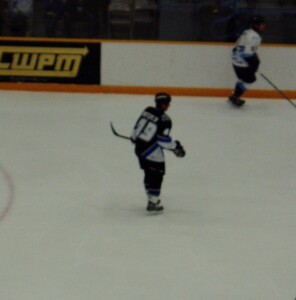
The Team: The Titans are entering their first season in the FHL, and they are the fifth low-minor team to play in Danbury, CT. They replace the Danbury Whalers (no affiliation with the dearly-departed Hartford Whalers), who moved across the state line to Brewster this offseason after five seasons in Danbury. The city has had a short but checkered hockey history. Their best-known club was the Danbury Trashers, playing in the now-defunct United Hockey League. Named for owner James Galante’s waste management business, the team folded in 2006 after two seasons thanks to Galante being charged with 72 counts of racketeering, including paying players for no-show jobs to circumvent the league salary cap (oh, and he regularly threatened, and once physically assaulted, league referees). After the Galante fiasco, Danbury was home to one-season-wonders New England Stars and Mad Hatters.
Going to a Game: The Titans play their games at the 3,000-seat Danbury Ice Arena. The arena is located one block from the Danbury MetroNorth station, with direct 2-hour service available from Grand Central. A game ticket costs around $15, and a season ticket is only $330.
The Team: After a successful five-year run as the Danbury Whalers, including a league championship in 2013, the club lost their lease and relocated to Brewster for the upcoming season. The small Westchester town has never had professional hockey before, but the area has a strong youth hockey culture, and the arena is home to several Junior A Tier III teams (a high level of hockey for players aged 16 and up), which has produced many Division I college players, and even a few NHLers.
Going to a Game: The Bulldogs will play their home games at the Brewster Ice Arena. Though the town of Brewster is reachable by the MetroNorth Hudson Valley Line, the rink is about 3.5 miles from the station, so if you don’t have a car, you will have to call a cab.
Honorable Mention: National Women’s Hockey League
The NWHL will kick off its inaugural season this weekend, with teams in Buffalo, Boston, Brooklyn, and Stamford, CT. The league is made up mostly of former college standouts, including US Olympians Brianna Decker (BOS), Hilary Knight (BOS), Megan Bozek (BUF), and Kelli Stack (CT). The New York Riveters, named in homage to the female industrial workers of World War II (like those at the Brooklyn Navy Yard), will play their games at the Aviator Sports Center, located at Floyd Bennett Field. While no American Olympians are on the roster, forward Lyudmilla Belyakova is a member of the Russian national team, and goalie Nana Fujimoto was Japan’s starter in Sochi. She will likely share the crease with one half of a husband-wife goaltending duo, as Jenny Scrivens is married to Edmonton Oilers backstop Ben Scrivens. Up I-95, another team will be resurrecting the ghost of the Whalers, as the Connecticut Whale will play their games at Chelsea Piers CT in Stamford.
College Hockey
Yale • Princeton • Quinnipiac • Sacred Heart • Army • Manhattanville
Like the minor leagues, college hockey is also in a state of flux, as conferences have realigned and the ground shifts beneath the entire NCAA. The entrance of Penn State into D-I hockey, thanks to $102 million donation by fracking billionaire and Buffalo Sabres owner Terry Pegula, led to the creation of a Big Ten hockey conference in 2013, attracting powerhouses like Michigan, Wisconsin, and Minnesota away from their leagues. But more significant are the looming changes to the NCAA. Canada’s major junior development leagues (OHL, WHL, QMJHL) are considered “professional” by the NCAA, forcing teenage players to make a choice to play college or forego college eligibility forever and play in Canada, drawing stark battle lines for players’ hearts, minds, and talents at the 49th parallel. But the litany of lawsuits challenging the cartel’s treatment of athletes and its definition of amateurism (as well as a few lodged against the Canadian leagues) could change this relationship entirely.
The Team: Yale truly shocked the world in 2013 when they won the school’s first-ever NCAA Division I national championship, beating teams like Minnesota, North Dakota, and next-door rival Quinnipiac to do it. Playing in the unofficial Ivy League (a sub-grouping of the ECAC), Yale does not award athletic scholarships, yet they have become a national powerhouse. For decades, Yale was a respectable, if mediocre program, led by long-time US national team coach Tim Taylor. With the promotion of assistant Keith Allain in 2006, the team has been transformed, regularly contending for a national title and attracting NHL-calibre talent. Circle the December 11 matchup against Boston University, who bounced the Bulldogs from last year’s NCAA tournament, and February 6, when they will host Harvard.
Going to a Game: You can reach New Haven in 1 hour 50 minutes on MetroNorth. Ingalls Rink is about a 30 minute walk from the train station, or you can grab the free shuttle bus from the station to the New Haven Green. Designed by architect Eero Saarinen, “The Whale” is one of the most distinctive stadiums in college hockey. While you’re there, head downstairs to see the newly-renovated team store and Yale Hockey Hall of Fame. Growing up in New Haven and playing youth hockey there, I’ve spent more time watching and playing hockey in this arena than probably any other on earth.
The Team: Princeton actually made the NCAA tournament as recently as 2009 (this is quite a feat considering only 16 teams make it, not 68 like in basketball), but the past two seasons have seen them fail to win more than a paltry 6 games. Princeton hockey’s most famous alumnus is Hobey Baker, a true star before there was an NHL or NCAA. After graduating Princeton, he joined the Army Air Service in World War I, and he was killed in December 1918 in a training accident. The award for the best player in college hockey is named in his honor, and his skates and other memorabilia are on display in the namesake Baker Rink.
Going to a Game: Princeton offers a very special venue in which to watch hockey, the 1923 Hobey Baker Memorial Rink, the second-oldest facility in college hockey. Princeton University is only about 90 minutes from Penn Station on Amtrak or NJ Transit, but you have to switch to Princeton Shuttle (aka Dinky Shuttle) once you reach Princeton Junction, which will deliver you just a few feet from the rink.
The Team: The Bobcats’ (né Braves) rise has been nothing short of meteoric. The program only entered Division I in 1999, and since then coach Rand Pecknold has led them to three NCAA tournaments and one finals appearance. Last season they ran roughshod over the ECAC, only to fall to a late-surging Harvard team in the conference semifinal.
Going to a Game: Once relegated to playing in front of a couple rows of bleachers at the town rink in nearby Northford, Quinnipiac opened the beautiful new TD Bank Sports Complex on their Hamden campus in 2006. If you want to show off your public transit skills, take the MetroNorth to New Haven and hop on the J bus towards Waterbury, and get off on the corner of Whitney Ave and Sherman Ave. Otherwise, take a taxi from the train station, or just drive.
Sacred Heart Pioneers (Atlantic Hockey)
The Team: Connecticut’s Sacred Heart University is entering their 23rd season of Division I men’s hockey. Not much to note here other than the fact that former Mets and Red Sox manager and Connecticut baseball legend Bobby Valentine is the school’s athletic director.
Going to a Game: The Pioneers play their home games at the Milford Ice Pavilion, which is the local town rink. You can take the MetroNorth from Grand Central to Milford, but you will need a car to take you the two miles out to the rink.
Army Black Knights (Atlantic Hockey)
The Team: Army hockey is better than Army football, but not by much. No offense to the cadets, but their program lags behind their Air Force counterparts, the only other service academy in Division I.
Going to a Game: The Black Knights play at Tate Rink on the campus of The United States Military Academy. West Point is just 60 miles north of New York City, but being on the west side of the Hudson River, it is largely inaccessible by public transit.
Manhattanville Valiants (D-III, ECAC West)
The Team: The northeast is literally riddled with small college hockey programs, but only Manhattanville is within close proximity to the city. The Valiants play in the six-team ECAC West, but they schedule many games against the liberal arts colleges of NESCAC. The women’s program is superior to the men’s, finishing as runners-up for the NCAA crown three times since 2002.
Going to a Game: Manhattanville plays its games at the regal PlayLand Ice Casino, located inside the amusement park in Rye, NY and right on the shore of Long Island Sound. MetroNorth will take you to Rye, but it’s a couple miles from the station to PlayLand.
Honorable Mention: NYU Violets
NYU is not known for their athletics, but the Violets do have a club hockey team that currently plays at the Chelsea Piers Sky Rink. The club’s coach has expressed interest in moving the team up to Division III in the near future, making it the first NCAA hockey team in the five boroughs. The hope is that ultimately the team will find a home at the Kingsbridge National Ice Center, which is planned for the massive Bronx armory complex, but construction is not set to begin until next year, at the earliest.

